Deck 24: Gausss Law
Question
Question
Question
Question
Question
Question
Question
Question
Question
Question
Question
Question
Question
Question
Question
Question
Question
Question
Question
Question
Question
Question
Question
Question
Question
Question
Question
Question
Question
Question
Question
Question
Question
Question
Question
Question
Question
Question
Question
Question
Question
Question
Question
Question
Question
Question

Unlock Deck
Sign up to unlock the cards in this deck!
Unlock Deck
Unlock Deck
1/46
Play
Full screen (f)
Deck 24: Gausss Law
1
The figure shows four Gaussian surfaces surrounding a distribution of charges. 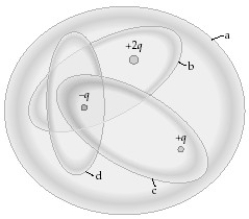
(a)Which Gaussian surfaces have an electric flux of +q/ε0 through them?
(b)Which Gaussian surfaces have no electric flux through them?

(a)Which Gaussian surfaces have an electric flux of +q/ε0 through them?
(b)Which Gaussian surfaces have no electric flux through them?
(a)b
(b)c
(b)c
2
The electric field strength in the space between two closely spaced parallel disks is 1.0 × 105 N/C.This field is the result of transferring 3.9 × 109 electrons from one disk to the other.What is the diameter of the disks? (e = 1.60 × 10-19 C,ε0 = 8.85 × 10-12 C2/N • m2)
A) 3.0 cm
B) 1.5 cm
C) 4.5 cm
D) 6.0 cm
A) 3.0 cm
B) 1.5 cm
C) 4.5 cm
D) 6.0 cm
3.0 cm
3
The graph in the figure shows the electric field strength (not the field lines)as a function of distance from the center for a pair of concentric uniformly charged spheres.Which of the following situations could the graph plausibly represent? (There may be more than one correct choice.) 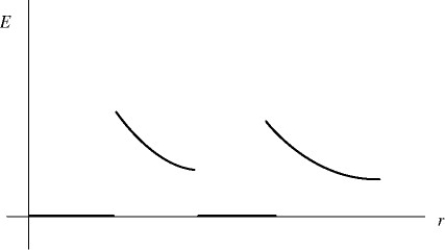
A) a positively charged conducting sphere within another positively charged conducting sphere
B) a positively charged conducting sphere within an uncharged conducting sphere
C) a solid nonconducting sphere, uniformly charged throughout its volume, inside of a positively charged conducting sphere
D) a positively charged nonconducting thin-walled spherical shell inside of a positively charged conducting sphere
E) a positively charged nonconducting thin-walled spherical shell inside of another positively charged nonconducting thin-walled spherical shell

A) a positively charged conducting sphere within another positively charged conducting sphere
B) a positively charged conducting sphere within an uncharged conducting sphere
C) a solid nonconducting sphere, uniformly charged throughout its volume, inside of a positively charged conducting sphere
D) a positively charged nonconducting thin-walled spherical shell inside of a positively charged conducting sphere
E) a positively charged nonconducting thin-walled spherical shell inside of another positively charged nonconducting thin-walled spherical shell
a positively charged conducting sphere within another positively charged conducting sphere
4
Which of the following statements about Gauss's law are correct? (There may be more than one correct choice.)
A) Gauss's law is valid only for symmetric charge distributions, such as spheres and cylinders.
B) If there is no charge inside of a Gaussian surface, the electric field must be zero at points of that surface.
C) Only charge enclosed within a Gaussian surface can produce an electric field at points on that surface.
D) If a Gaussian surface is completely inside an electrostatic conductor, the electric field must always be zero at all points on that surface.
E) The electric flux passing through a Gaussian surface depends only on the amount of charge inside that surface, not on its size or shape.
A) Gauss's law is valid only for symmetric charge distributions, such as spheres and cylinders.
B) If there is no charge inside of a Gaussian surface, the electric field must be zero at points of that surface.
C) Only charge enclosed within a Gaussian surface can produce an electric field at points on that surface.
D) If a Gaussian surface is completely inside an electrostatic conductor, the electric field must always be zero at all points on that surface.
E) The electric flux passing through a Gaussian surface depends only on the amount of charge inside that surface, not on its size or shape.

Unlock Deck
Unlock for access to all 46 flashcards in this deck.
Unlock Deck
k this deck
5
If the electric flux through a closed surface is zero,the electric field at points on that surface must be zero.

Unlock Deck
Unlock for access to all 46 flashcards in this deck.
Unlock Deck
k this deck
6
An electric field is set up between two parallel plates,each of area 2.0 m2,by putting 1.0 μC of charge on one plate and -1.0 μC of charge on the other.The plates are separated by 4.0 mm with their centers opposite each other,and the charges are distributed uniformly over the surface of the plates.What is the magnitude of the electric field between the plates at a distance of 1.0 mm from the positive plate,but not near the edges of the plates? (ε0 = 8.85 × 10-12 C2/N • m2)
A) 4.2 × 104 N/C
B) 1.4 × 104 N/C
C) 3.1 × 104 N/C
D) 0.00 N/C
E) 5.6 × 104 N/C
A) 4.2 × 104 N/C
B) 1.4 × 104 N/C
C) 3.1 × 104 N/C
D) 0.00 N/C
E) 5.6 × 104 N/C

Unlock Deck
Unlock for access to all 46 flashcards in this deck.
Unlock Deck
k this deck
7
If a rectangular area is rotated in a uniform electric field from the position where the maximum electric flux goes through it to an orientation where only half the flux goes through it,what has been the angle of rotation?
A) 45°
B) 26.6°
C) 90°
D) 30°
E) 60°
A) 45°
B) 26.6°
C) 90°
D) 30°
E) 60°

Unlock Deck
Unlock for access to all 46 flashcards in this deck.
Unlock Deck
k this deck
8
The cube of insulating material shown in the figure has one corner at the origin.Each side of the cube has length 0.080 m so the top face of the cube is parallel to the xz-plane and is at y = 0.080 m.It is observed that there is an electric field 
that is in the +y direction and whose magnitude depends only on y.Use Gauss's law to calculate the net charge enclosed by the cube.
(ε0 = 8.85 × 10-12 C2/N • m2)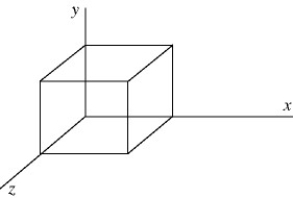

that is in the +y direction and whose magnitude depends only on y.Use Gauss's law to calculate the net charge enclosed by the cube.
(ε0 = 8.85 × 10-12 C2/N • m2)


Unlock Deck
Unlock for access to all 46 flashcards in this deck.
Unlock Deck
k this deck
9
At a distance D from a very long (essentially infinite)uniform line of charge,the electric field strength is 1000 N/C.At what distance from the line will the field strength to be 2000 N/C?
A) 2D
B) D
D
C) D/
D) D/2
E) D/4
A) 2D
B)
 D
DC) D/

D) D/2
E) D/4

Unlock Deck
Unlock for access to all 46 flashcards in this deck.
Unlock Deck
k this deck
10
Two very large parallel sheets a distance d apart have their centers directly opposite each other.The sheets carry equal but opposite uniform surface charge densities.A point charge that is placed near the middle of the sheets a distance d/2 from each of them feels an electrical force F due to the sheets.If this charge is now moved closer to one of the sheets so that it is a distance d/4 from that sheet,what force will feel?
A) 4F
B) 2F
C) F
D) F/2
E) F/4
A) 4F
B) 2F
C) F
D) F/2
E) F/4

Unlock Deck
Unlock for access to all 46 flashcards in this deck.
Unlock Deck
k this deck
11
A nonuniform electric field is directed along the x-axis at all points in space.This magnitude of the field varies with x,but not with respect to y or z.The axis of a cylindrical surface,0.80 m long and 0.20 m in diameter,is aligned parallel to the x-axis,as shown in the figure.The electric fields E1 and E2,at the ends of the cylindrical surface,have magnitudes of 6000 N/C and 1000 N/C respectively,and are directed as shown.What is the net electric flux passing through the cylindrical surface? 
A) -160 N • m2/C
B) -350 N • m2/C
C) 0.00 N • m2/C
D) +350 N • m2/C
E) +160 N • m2/C

A) -160 N • m2/C
B) -350 N • m2/C
C) 0.00 N • m2/C
D) +350 N • m2/C
E) +160 N • m2/C

Unlock Deck
Unlock for access to all 46 flashcards in this deck.
Unlock Deck
k this deck
12
Two long straight parallel lines,#1 and #2,carry uniform positive linear charge densities.The charge density on line #2 is twice as great as the charge density on line #1.The locus of points where the electric field due to these lines is zero is
A) along a line between the lines closer to line #2 than line #1.
B) at a point midway between the lines.
C) along a line perpendicular to lines #1 and #2.
D) along a line between the lines closer to line #1 than line #2.
A) along a line between the lines closer to line #2 than line #1.
B) at a point midway between the lines.
C) along a line perpendicular to lines #1 and #2.
D) along a line between the lines closer to line #1 than line #2.

Unlock Deck
Unlock for access to all 46 flashcards in this deck.
Unlock Deck
k this deck
13
A charge Q is uniformly spread over one surface of a very large nonconducting square elastic sheet having sides of length d.At a point P that is 1.25 cm outside the sheet,the magnitude of the electric field due to the sheet is E.If the sheet is now stretched so that its sides have length 2d,what is the magnitude of the electric field at P?
A) 4E
B) 2E
C) E
D) E/2
E) E/4
A) 4E
B) 2E
C) E
D) E/2
E) E/4

Unlock Deck
Unlock for access to all 46 flashcards in this deck.
Unlock Deck
k this deck
14
An uncharged conductor has a hollow cavity inside of it.Within this cavity there is a charge of +10 µC that does not touch the conductor.There are no other charges in the vicinity.Which statement about this conductor is true? (There may be more than one correct choice.)
A) The inner surface of the conductor carries a charge of -10 µC and its outer surface carries no excess charge.
B) The inner and outer surfaces of the conductor each contain charges of -5 µC.
C) The net electric field within the material of the conductor points away from the +10 µC charge.
D) The outer surface of the conductor contains +10 µC of charge and the inner surface contains -10 µC.
E) Both surfaces of the conductor carry no excess charge because the conductor is uncharged.
A) The inner surface of the conductor carries a charge of -10 µC and its outer surface carries no excess charge.
B) The inner and outer surfaces of the conductor each contain charges of -5 µC.
C) The net electric field within the material of the conductor points away from the +10 µC charge.
D) The outer surface of the conductor contains +10 µC of charge and the inner surface contains -10 µC.
E) Both surfaces of the conductor carry no excess charge because the conductor is uncharged.

Unlock Deck
Unlock for access to all 46 flashcards in this deck.
Unlock Deck
k this deck
15
Two very large,flat plates are parallel to each other. Plate A,located at y = 1.0 cm,is along the xz-plane and carries a uniform surface charge density -1.00 μC/m2. Plate B is located at y = -1.0 cm and carries a uniform surface charge density +2.00 μC/m2.What is the electric field vector at the point having x,y,z coordinates (-0.50 cm,0.00 cm,0.00 cm)? (ε0 = 8.85 × 10-12 C2/N • m2)
A) (+1.13 × 105 N/C)
B) (-2.83 × 105 N/C)
C) (+1.19 × 105 N/C)
D) (+1.69 × 105 N/C)
E) (-1.19 × 105 N/C)
A) (+1.13 × 105 N/C)

B) (-2.83 × 105 N/C)

C) (+1.19 × 105 N/C)

D) (+1.69 × 105 N/C)

E) (-1.19 × 105 N/C)


Unlock Deck
Unlock for access to all 46 flashcards in this deck.
Unlock Deck
k this deck
16
Two flat 4.0 cm × 4.0 cm electrodes carrying equal but opposite charges are spaced 2.0 mm apart with their midpoints opposite each other.Between the electrodes but not near their edges,the electric field strength is 2.5 × 106 N/C.What is the magnitude of the charge on each electrode?
(ε0 = 8.85 × 10-12 C2/N • m2)
A) 35 nC
B) 18 nC
C) 16 nC
D) 30 nC
(ε0 = 8.85 × 10-12 C2/N • m2)
A) 35 nC
B) 18 nC
C) 16 nC
D) 30 nC

Unlock Deck
Unlock for access to all 46 flashcards in this deck.
Unlock Deck
k this deck
17
Consider a spherical Gaussian surface of radius R centered at the origin.A charge Q is placed inside the sphere.To maximize the magnitude of the flux of the electric field through the Gaussian surface,the charge should be located
A) at x = 0, y = 0, z = R/2.
B) at the origin.
C) at x = R/2, y = 0, z = 0.
D) at x = 0, y = R/2, z = 0.
E) The charge can be located anywhere, since flux does not depend on the position of the charge as long as it is inside the sphere.
A) at x = 0, y = 0, z = R/2.
B) at the origin.
C) at x = R/2, y = 0, z = 0.
D) at x = 0, y = R/2, z = 0.
E) The charge can be located anywhere, since flux does not depend on the position of the charge as long as it is inside the sphere.

Unlock Deck
Unlock for access to all 46 flashcards in this deck.
Unlock Deck
k this deck
18
Two large,flat,horizontally oriented plates are parallel to each other,a distance d apart.Half way between the two plates the electric field has magnitude E.If the separation of the plates is reduced to d/2 what is the magnitude of the electric field half way between the plates?
A) 4E
B) 2E
C) E
D) 0
E) E/2
A) 4E
B) 2E
C) E
D) 0
E) E/2

Unlock Deck
Unlock for access to all 46 flashcards in this deck.
Unlock Deck
k this deck
19
A cone is resting on a tabletop as shown in the figure with its face horizontal.A uniform electric field of magnitude 4550 N/C points vertically upward.How much electric flux passes through the sloping side surface area of the cone? 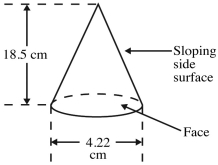


Unlock Deck
Unlock for access to all 46 flashcards in this deck.
Unlock Deck
k this deck
20
Under electrostatic conditions,the electric field just outside the surface of any charged conductor
A) is always parallel to the surface.
B) is always zero because the electric field is zero inside conductors.
C) is always perpendicular to the surface of the conductor.
D) is perpendicular to the surface of the conductor only if it is a sphere, a cylinder, or a flat sheet.
E) can have nonzero components perpendicular to and parallel to the surface of the conductor.
A) is always parallel to the surface.
B) is always zero because the electric field is zero inside conductors.
C) is always perpendicular to the surface of the conductor.
D) is perpendicular to the surface of the conductor only if it is a sphere, a cylinder, or a flat sheet.
E) can have nonzero components perpendicular to and parallel to the surface of the conductor.

Unlock Deck
Unlock for access to all 46 flashcards in this deck.
Unlock Deck
k this deck
21
A non-conducting sphere of radius R = 7.0 cm carries a charge Q = 4.0 mC distributed uniformly throughout its volume.At what distance,measured from the center of the sphere,does the electric field reach a value equal to half its maximum value?
A) 3.5 cm only
B) 4.9 cm only
C) 3.5 cm and 9.9 cm
D) 3.5 cm and 4.9 cm
E) 9.9 cm only
A) 3.5 cm only
B) 4.9 cm only
C) 3.5 cm and 9.9 cm
D) 3.5 cm and 4.9 cm
E) 9.9 cm only

Unlock Deck
Unlock for access to all 46 flashcards in this deck.
Unlock Deck
k this deck
22
A very large sheet of a conductor carries a uniform charge density of 4.00 pC/mm2 on its surfaces.What is the electric field strength 3.00 mm outside the surface of the conductor?
(ε0 = 8.85 × 10-12 C2/N • m2)
A) 4.52 × 105 N/C
B) 2.26 × 105 N/C
C) 9.04 × 105 N/C
D) 0.452 N/C
E) 0.226 N/C
(ε0 = 8.85 × 10-12 C2/N • m2)
A) 4.52 × 105 N/C
B) 2.26 × 105 N/C
C) 9.04 × 105 N/C
D) 0.452 N/C
E) 0.226 N/C

Unlock Deck
Unlock for access to all 46 flashcards in this deck.
Unlock Deck
k this deck
23
A huge (essentially infinite)horizontal nonconducting sheet 10.0 cm thick has charge uniformly spread over both faces.The upper face carries +95.0 nC/m2 while the lower face carries -25.0 nC/ m2.What is the magnitude of the electric field at a point within the sheet 2.00 cm below the upper face?
(ε0 = 8.85 × 10-12 C2/N • m2)
A) 0.00 N/C
B) 3.95 × 103 N/C
C) 6.78 × 103 N/C
D) 7.91 × 103 N/C
E) 1.36 × 104 N/C
(ε0 = 8.85 × 10-12 C2/N • m2)
A) 0.00 N/C
B) 3.95 × 103 N/C
C) 6.78 × 103 N/C
D) 7.91 × 103 N/C
E) 1.36 × 104 N/C

Unlock Deck
Unlock for access to all 46 flashcards in this deck.
Unlock Deck
k this deck
24
A solid nonconducting sphere of radius R carries a charge Q distributed uniformly throughout its volume.At a certain distance r1 (r1 < R)from the center of the sphere,the electric field has magnitude E.If the same charge Q were distributed uniformly throughout a sphere of radius 2R,the magnitude of the electric field at the same distance r1 from the center would be equal to
A) E/8.
B) E/2.
C) 2E.
D) 8E.
E) E.
A) E/8.
B) E/2.
C) 2E.
D) 8E.
E) E.

Unlock Deck
Unlock for access to all 46 flashcards in this deck.
Unlock Deck
k this deck
25
Two concentric conducting spherical shells produce a radially outward electric field of magnitude 49,000 N/C at a point 4.10 m from the center of the shells.The outer surface of the larger shell has a radius of 3.75 m.If the inner shell contains an excess charge of -5.30 μC,find the amount of charge on the outer surface of the larger shell.(k = 1/4πε0 = 8.99 × 109 N ∙ m2/C2)

Unlock Deck
Unlock for access to all 46 flashcards in this deck.
Unlock Deck
k this deck
26
A nonuniform electric field is directed along the x-axis at all points in space.This magnitude of the field varies with x,but not with respect to y or z.The axis of a cylindrical surface,0.80 m long and 0.20 m in diameter,is aligned parallel to the x-axis,as shown in the figure.The electric fields E1 and E2,at the ends of the cylindrical surface,have magnitudes of 9000 N/C and 5000 N/C respectively,and are directed as shown.(ε0 = 8.85 × 10-12 C2/N • m2)The charge enclosed by the cylindrical surface is closest to 
A) -1.1 nC.
B) 1.1 nC.
C) -2.4 nC.
D) -4.8 nC.
E) 4.8 nC.

A) -1.1 nC.
B) 1.1 nC.
C) -2.4 nC.
D) -4.8 nC.
E) 4.8 nC.

Unlock Deck
Unlock for access to all 46 flashcards in this deck.
Unlock Deck
k this deck
27
A spherical,non-conducting shell of inner radius r1 = 10 cm and outer radius r2 = 15 cm carries a total charge Q = 15 μC distributed uniformly throughout the volume of the shell.What is the magnitude of the electric field at a distance r = 12 cm from the center of the shell? (k = 1/4πε0 = 8.99 × 109 N • m2/C2)
A) 5.75 × 103 N/C
B) zero
C) 2.87 × 106 N/C
D) 5.75 × 106 N/C
E) 2.87 × 103 N/C
A) 5.75 × 103 N/C
B) zero
C) 2.87 × 106 N/C
D) 5.75 × 106 N/C
E) 2.87 × 103 N/C

Unlock Deck
Unlock for access to all 46 flashcards in this deck.
Unlock Deck
k this deck
28
A nonconducting spherical shell of inner radius R1 and outer radius R2 contains a uniform volume charge density ρ throughout the shell.Use Gauss's law to derive an equation for the magnitude of the electric field at the following radial distances r from the center of the sphere.Your answers should be in terms of ρ,R1,R2,r,ε0 ,and π.
(a)r < R1
(b)R1 < r < R2
(c)r > R2
(a)r < R1
(b)R1 < r < R2
(c)r > R2

Unlock Deck
Unlock for access to all 46 flashcards in this deck.
Unlock Deck
k this deck
29
An infinitely long nonconducting cylinder of radius R = 2.00 cm carries a uniform volume charge density of 18.0 µC/m3. Calculate the electric field at distance r = 1.00 cm from the axis of the cylinder. (ε0 = 8.85 × 10-12 C2/N • m2)
A) 2.50 × 103 N/C
B) 5.10 × 103 N/C
C) zero
D) 2.00 × 103 N/C
E) 10.2 × 103 N/C
A) 2.50 × 103 N/C
B) 5.10 × 103 N/C
C) zero
D) 2.00 × 103 N/C
E) 10.2 × 103 N/C

Unlock Deck
Unlock for access to all 46 flashcards in this deck.
Unlock Deck
k this deck
30
The cross section of a long coaxial cable is shown in the figure,with radii as given.The linear charge density on the inner conductor is -30 nC/m and the linear charge density on the outer conductor is
-70 nC/m. The inner and outer cylindrical surfaces are respectively denoted by A,B,C,and D,as shown.(ε0 = 8.85 × 10-12 C2/N • m2) The radial component of the electric field at a point that 34 mm from the axis is closest to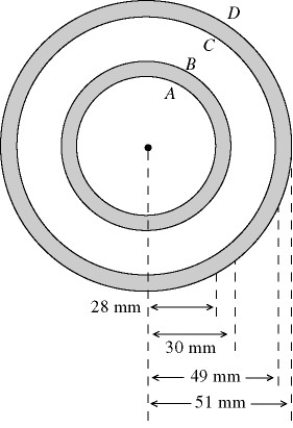
A) -16,000 N/C.
B) +16,000 N/C.
C) -37,000 N/C.
D) +37,000 N/C.
E) zero
-70 nC/m. The inner and outer cylindrical surfaces are respectively denoted by A,B,C,and D,as shown.(ε0 = 8.85 × 10-12 C2/N • m2) The radial component of the electric field at a point that 34 mm from the axis is closest to

A) -16,000 N/C.
B) +16,000 N/C.
C) -37,000 N/C.
D) +37,000 N/C.
E) zero

Unlock Deck
Unlock for access to all 46 flashcards in this deck.
Unlock Deck
k this deck
31
A solid nonconducting sphere of radius R carries a uniform charge density throughout its volume.At a radial distance r1 = R/4 from the center,the electric field has a magnitude E0. What is the magnitude of the electric field at a radial distance r2 = 2R?
A) E0/4
B) zero
C) E0/2
D) E0
E) 2E0
A) E0/4
B) zero
C) E0/2
D) E0
E) 2E0

Unlock Deck
Unlock for access to all 46 flashcards in this deck.
Unlock Deck
k this deck
32
Four dipoles,each consisting of a +10-µC charge and a -10-µC charge,are located in the xy-plane with their centers 1.0 mm from the origin,as shown.A sphere passes through the dipoles,as shown in the figure.What is the electric flux through the sphere due to these dipoles? (ε0 = 8.85 × 10-12 C2/N • m2) 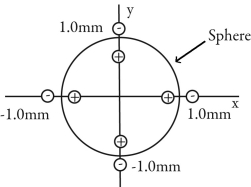
A) 4.5 × 106 N • m2/C
B) 0.00 N • m2/C
C) 9.0 × 106 N • m2/C
D) 11 × 105 N • m2/C

A) 4.5 × 106 N • m2/C
B) 0.00 N • m2/C
C) 9.0 × 106 N • m2/C
D) 11 × 105 N • m2/C

Unlock Deck
Unlock for access to all 46 flashcards in this deck.
Unlock Deck
k this deck
33
The cross section of a long coaxial cable is shown in the figure,with radii as given.The linear charge density on the inner conductor is -40 nC/m and the linear charge density on the outer conductor is
-50 nC/m.The inner and outer cylindrical surfaces are respectively denoted by A,B,C,and D,as shown.(ε0 = 8.85 × 10-12 C2/N • m2) The magnitude of the electric field at a point that is 94 mm from the axis is closest to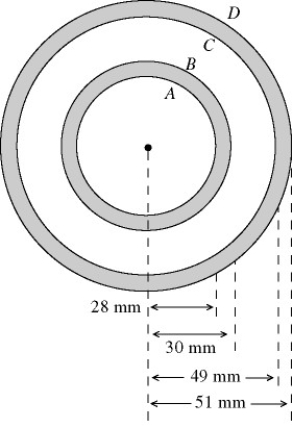
A) 17,000 N/C.
B) 15,000 N/C.
C) 13,000 N/C.
D) 11,000 N/C.
E) 9600 N/C.
-50 nC/m.The inner and outer cylindrical surfaces are respectively denoted by A,B,C,and D,as shown.(ε0 = 8.85 × 10-12 C2/N • m2) The magnitude of the electric field at a point that is 94 mm from the axis is closest to

A) 17,000 N/C.
B) 15,000 N/C.
C) 13,000 N/C.
D) 11,000 N/C.
E) 9600 N/C.

Unlock Deck
Unlock for access to all 46 flashcards in this deck.
Unlock Deck
k this deck
34
Charge is distributed uniformly throughout a large insulating cylinder of radius R.The charge per unit length in the cylindrical volume is λ.
(a)Use Gauss's law to find the magnitude of the electric field at a distance r from the central axis of the cylinder for r < R.Your answer should be in terms of r,R,λ,ε0 ,and π.
(b)Check the reasonableness of your answer by evaluating it at the surface of the cylinder.
(a)Use Gauss's law to find the magnitude of the electric field at a distance r from the central axis of the cylinder for r < R.Your answer should be in terms of r,R,λ,ε0 ,and π.
(b)Check the reasonableness of your answer by evaluating it at the surface of the cylinder.

Unlock Deck
Unlock for access to all 46 flashcards in this deck.
Unlock Deck
k this deck
35
Electric charge is uniformly distributed inside a nonconducting sphere of radius 0.30 m.The electric field at a point P,which is 0.50 m from the center of the sphere,is 15,000 N/C and is directed radially outward.What is the maximum magnitude of the electric field due to this sphere?
A) 25,000 N/C
B) 30,000 N/C
C) 36,000 N/C
D) 42,000 N/C
E) 48,000 N/C
A) 25,000 N/C
B) 30,000 N/C
C) 36,000 N/C
D) 42,000 N/C
E) 48,000 N/C

Unlock Deck
Unlock for access to all 46 flashcards in this deck.
Unlock Deck
k this deck
36
A charge of 1.0 × 10-6 μC is located inside a sphere,1.25 cm from its center.What is the electric flux through the sphere due to this charge? (ε0 = 8.85 × 10-12 C2/N • m2)
A) 0.11 N • m2/C
B) 8.9 N • m2/C
C) 0.028π N • m2/C
D) It cannot be determined without knowing the radius of the sphere.
A) 0.11 N • m2/C
B) 8.9 N • m2/C
C) 0.028π N • m2/C
D) It cannot be determined without knowing the radius of the sphere.

Unlock Deck
Unlock for access to all 46 flashcards in this deck.
Unlock Deck
k this deck
37
A charge q = 2.00 μC is placed at the origin in a region where there is already a uniform electric
Field
= (100 N/C)
)Calculate the flux of the net electric field through a Gaussian sphere of radius
R = 10.0 cm centered at the origin.(ε0 = 8.85 × 10-12 C2/N • m2)
A) 5.52 × 105 N • m2/C
B) 1.13 × 105 N • m2/C
C) 2.26 × 105 N • m2/C
D) zero
Field

= (100 N/C)

)Calculate the flux of the net electric field through a Gaussian sphere of radius
R = 10.0 cm centered at the origin.(ε0 = 8.85 × 10-12 C2/N • m2)
A) 5.52 × 105 N • m2/C
B) 1.13 × 105 N • m2/C
C) 2.26 × 105 N • m2/C
D) zero

Unlock Deck
Unlock for access to all 46 flashcards in this deck.
Unlock Deck
k this deck
38
As shown in the figure,a square insulating slab 5.0 mm thick measuring 2.0 m × 2.0 m has a charge of 8.0 × 10-11 C distributed uniformly throughout its volume.Use Gauss's law to determine the electric field at point P,which is located within the slab beneath its center,1.0 mm from one of the faces.
(ε0 = 8.85 × 10-12 C2/N • m2)
A) 0.68 N/C
B) 14 N/C
C) 23 N/C
D) 34 N/C
E) 57 N/C
(ε0 = 8.85 × 10-12 C2/N • m2)

A) 0.68 N/C
B) 14 N/C
C) 23 N/C
D) 34 N/C
E) 57 N/C

Unlock Deck
Unlock for access to all 46 flashcards in this deck.
Unlock Deck
k this deck
39
Two concentric spheres are shown in the figure.The inner sphere is a solid nonconductor and carries a charge of +5.00 µC uniformly distributed over its outer surface.The outer sphere is a conducting shell that carries a net charge of -8.00 µC.No other charges are present.The radii shown in the figure have the values R1 = 10.0 cm,R2 = 20.0 cm,and R3 = 30.0 cm.(k = 1/4πε0 = 8.99 × 109 N • m2/C2)
(a)Find the total excess charge on the inner and outer surfaces of the conducting sphere.
(b)Find the magnitude and direction of the electric field at the following distances r from the center of the inner sphere: (i)r = 9.5 cm,(ii)r = 15.0 cm,(iii)r = 27.0 cm,(iv)r = 35.0 cm.
(a)Find the total excess charge on the inner and outer surfaces of the conducting sphere.
(b)Find the magnitude and direction of the electric field at the following distances r from the center of the inner sphere: (i)r = 9.5 cm,(ii)r = 15.0 cm,(iii)r = 27.0 cm,(iv)r = 35.0 cm.


Unlock Deck
Unlock for access to all 46 flashcards in this deck.
Unlock Deck
k this deck
40
Electric charge is uniformly distributed inside a nonconducting sphere of radius 0.30 m.The electric field at a point P,which is 0.50 m from the center of the sphere,is 15,000 N/C and is directed radially outward.At what distance from the center of the sphere does the electric field have the same magnitude as it has at P?
A) 0.11 m
B) 0.13 m
C) 0.15 m
D) 0.17 m
E) at no other point
A) 0.11 m
B) 0.13 m
C) 0.15 m
D) 0.17 m
E) at no other point

Unlock Deck
Unlock for access to all 46 flashcards in this deck.
Unlock Deck
k this deck
41
A hollow conducting spherical shell has radii of 0.80 m and 1.20 m,as shown in the figure.The sphere carries a net excess charge of -500 nC.A point charge of +300 nC is present at the center.
(k = 1/4πε0 = 8.99 × 109 N • m2/C)The radial component of the electric field at a point that is 1.50 m from the center is closest to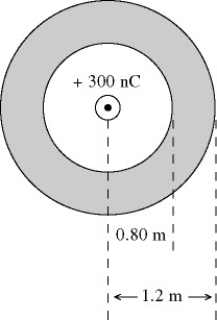
A) +1200 N/C.
B) +2000 N/C.
C) -800 N/C.
D) -1600 N/C.
E) -2000 N/C.
(k = 1/4πε0 = 8.99 × 109 N • m2/C)The radial component of the electric field at a point that is 1.50 m from the center is closest to

A) +1200 N/C.
B) +2000 N/C.
C) -800 N/C.
D) -1600 N/C.
E) -2000 N/C.

Unlock Deck
Unlock for access to all 46 flashcards in this deck.
Unlock Deck
k this deck
42
A neutral hollow spherical conducting shell of inner radius 1.00 cm and outer radius 3.00 cm has a +2.00-µC point charge placed at its center.Find the surface charge density
(a)on the inner surface of the shell.
(b)on the outer surface of the shell.
(a)on the inner surface of the shell.
(b)on the outer surface of the shell.

Unlock Deck
Unlock for access to all 46 flashcards in this deck.
Unlock Deck
k this deck
43
A hollow conducting spherical shell has radii of 0.80 m and 1.20 m,as shown in the figure.The sphere carries a net excess charge of -500 nC.A point charge of +300 nC is present at the center.
(k = 1/4πε0 = 8.99 × 109 N • m2/C)The radial component of the electric field at a point that is 0.60 m from the center is closest to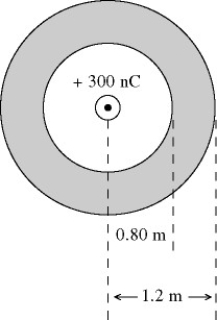
A) zero.
B) +5000 N/C.
C) +7500 N/C.
D) -5000 N/C.
E) -7500 N/C.
(k = 1/4πε0 = 8.99 × 109 N • m2/C)The radial component of the electric field at a point that is 0.60 m from the center is closest to

A) zero.
B) +5000 N/C.
C) +7500 N/C.
D) -5000 N/C.
E) -7500 N/C.

Unlock Deck
Unlock for access to all 46 flashcards in this deck.
Unlock Deck
k this deck
44
A hollow conducting spherical shell has radii of 0.80 m and 1.20 m,as shown in the figure.The sphere carries an excess charge of -500 nC.A point charge of +300 nC is present at the center.The surface charge density on the inner spherical surface is closest to 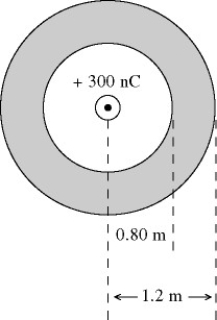
A) zero.
B) +4.0 × 10-8 C/m2.
C) +6.0 × 10-8 C/m2.
D) -4.0 × 10-8 C/m2.
E) -6.0 × 10-8 C/m2.

A) zero.
B) +4.0 × 10-8 C/m2.
C) +6.0 × 10-8 C/m2.
D) -4.0 × 10-8 C/m2.
E) -6.0 × 10-8 C/m2.

Unlock Deck
Unlock for access to all 46 flashcards in this deck.
Unlock Deck
k this deck
45
Two extremely large nonconducting horizontal sheets each carry uniform charge density on the surfaces facing each other.The upper sheet carries +5.00 µC/m2.The electric field midway between the sheets is 4.25 × 105 N/C pointing downward.What is the surface charge density on the lower sheet?
(ε0 = 8.85 × 10-12 C2/N • m2)
(ε0 = 8.85 × 10-12 C2/N • m2)

Unlock Deck
Unlock for access to all 46 flashcards in this deck.
Unlock Deck
k this deck
46
Consider two closely spaced and oppositely charged parallel metal plates.The plates are square with sides of length L and carry charges Q and -Q on their facing surfaces.What is the magnitude of the electric field in the region between the plates?
A) E =
B) E =
C) E = 0
D) E =
E) E =
A) E =

B) E =

C) E = 0
D) E =

E) E =


Unlock Deck
Unlock for access to all 46 flashcards in this deck.
Unlock Deck
k this deck



